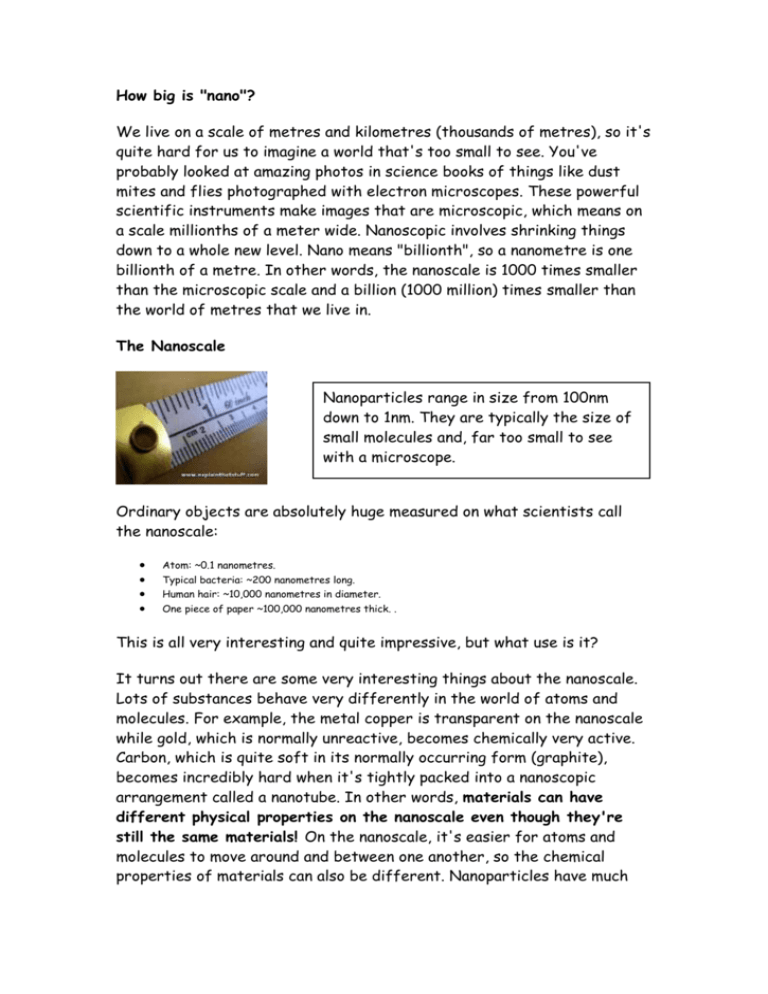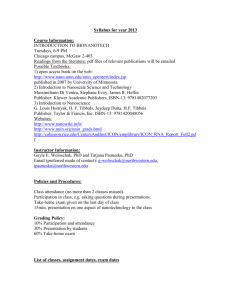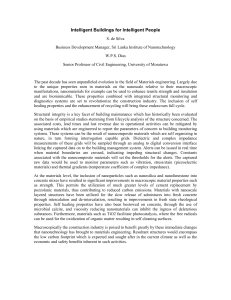Nanotechnology
advertisement

How big is "nano"? We live on a scale of metres and kilometres (thousands of metres), so it's quite hard for us to imagine a world that's too small to see. You've probably looked at amazing photos in science books of things like dust mites and flies photographed with electron microscopes. These powerful scientific instruments make images that are microscopic, which means on a scale millionths of a meter wide. Nanoscopic involves shrinking things down to a whole new level. Nano means "billionth", so a nanometre is one billionth of a metre. In other words, the nanoscale is 1000 times smaller than the microscopic scale and a billion (1000 million) times smaller than the world of metres that we live in. The Nanoscale Nanoparticles range in size from 100nm down to 1nm. They are typically the size of small molecules and, far too small to see with a microscope. Ordinary objects are absolutely huge measured on what scientists call the nanoscale: Atom: ~0.1 nanometres. Typical bacteria: ~200 nanometres long. Human hair: ~10,000 nanometres in diameter. One piece of paper ~100,000 nanometres thick. . This is all very interesting and quite impressive, but what use is it? It turns out there are some very interesting things about the nanoscale. Lots of substances behave very differently in the world of atoms and molecules. For example, the metal copper is transparent on the nanoscale while gold, which is normally unreactive, becomes chemically very active. Carbon, which is quite soft in its normally occurring form (graphite), becomes incredibly hard when it's tightly packed into a nanoscopic arrangement called a nanotube. In other words, materials can have different physical properties on the nanoscale even though they're still the same materials! On the nanoscale, it's easier for atoms and molecules to move around and between one another, so the chemical properties of materials can also be different. Nanoparticles have much more surface area exposed to other nanoparticles, so they are very good as catalysts (substances that speed up chemical reactions). A carbon nanotube. Nanomaterials. It could be you're already using nanotechnology. You might be wearing nanotechnology pants (that's "trousers" to you in the UK), walking on a nanotechnology rug, sleeping on nanotechnology sheets, or hauling nanotechnology luggage to the airport. All these products are made from fabrics coated with "nanowhiskers." These tiny surface fibres are so small that dirt cannot penetrate into them, which means the deeper layers of material stay clean. Some brands of sunscreens use nanotechnology in a similar way; they coat your skin with a layer of nanoscopic titanium dioxide or zinc oxide that blocks out the Sun’s harmful ultraviolet rays.Nano coatings are also appearing on sratch-resistant car bumpers, anti-slip steps on vans and buses, corrosion resistant paints and wound dressings. Even the inside of your refrigerators have a silver nano coating on their inner surfaces for an overall anti-bacterial and anti-fungal effect. As air circulates, the coated surfaces contact with the silver ions which can resist any airborne bacteria, , and inhibits cell growth. Carbon nanotubes are among the most exciting of nanomaterials. These rod-shaped carbon molecules are roughly one nanometre across. Although they are hollow, their densely packed structure makes them incredibly strong and they can be grown into fibres of virtually any length. NASA scientists have recently proposed carbon nanotubes could be used to make a gigantic elevator stretching all the way from Earth into space. Equipment and people could be shuttled slowly up and down this “carbon ladder” saving the need for expensive rocket flights. One form of nanotechnology we all use is microelectronics. The "micro" part of that word suggests computer chips work on the microscopic scale—and they do. But since terms like "microchip" were coined in the 1970s, electronic engineers have found ways of packing even more transistor switches into integrated circuits to make computers that are smaller, faster, and cheaper than ever before. Everyday transistors in the early 21st-century are just 100–200 nanometres wide, but cuttingedge experiments are already developing much smaller devices. In 1998, scientists made a transistor from a single carbon nanotube. And it's not just the chips inside computers that use nanotechnology. The displays on everything from ipods and cellphones to laptops and flatscreen TVs are shifting to organic light-emitting diodes made from plastic films built on the nanoscale. Nanomachines One of the most exciting areas of nanotechnology is the possibility of building incredibly small machines—things like gears, switches, pumps , or engines —from individual atoms. Nanomachines could be made into nanorobots (sometimes called nanobots) that could be injected into our bodies to carry out repairs or sent into hazardous or dangerous environments, perhaps to clean up disused nuclearplants. The future of nanotechnology: nanodream or nano-nightmare? Engineers the world over are raving about nanotechnology. This is what scientists at one of America's premier research institutions, the Los Alamos National Laboratory, have to say: "The new concepts of nanotechnology are so broad and pervasive, that they will influence every area of technology and science, in ways that are surely unpredictable.... The total societal impact of nanotechnology is expected to be greater than the combined influences that the silicon integrated circuit, medical imaging, computer-aided engineering, and man-made polymers have had in this century." That's a pretty amazing claim: 21st-century nanotechnology will be more important than all the greatest technologies of the 20th century put together! Photo: These nanogears were made by attaching benzene molecules (outer white blobs) to the outsides of carbon nanotubes (inner grey rings). Could there be problems in the future? Nanotechnology sounds like a world of great promise, but there are controversial issues too that must be considered and resolved. Some people have raised concerns that nanoscale organisms or machines could harm human life or the environment. One problem is that tiny particles can be extremely toxic to the human body. No-one really knows what harmful effect new nanomaterials or substances could have. Chemical pesticides were not considered harmful when they were first used in the early decades of the 20th century; it wasn't until the 1960s and 1970s that their potentially harmful effects were properly understood. Could the same happen with nanotechnology? The ultimate nano-nightmare, the problem of "grey goo," was first highlighted by Eric Drexler. What happens if well-meaning humans create nanobots that run riot through the biosphere, gobbling up all living things and leaving behind nothing but a chewed-up mass of "grey goo"? Critics of nanotechnology argue humans shouldn't meddle with worlds they don't understand, but if we took that argument to its logical conclusion, we'd have no inventions at all—no medicines, no transportation, no agriculture, and no education—and we'd still be living in the Stone Age. The real question is whether the promise of nanotechnology is greater than any potential risks that go with it. And that will determine whether our nanofuture becomes dream—or nightmare.






